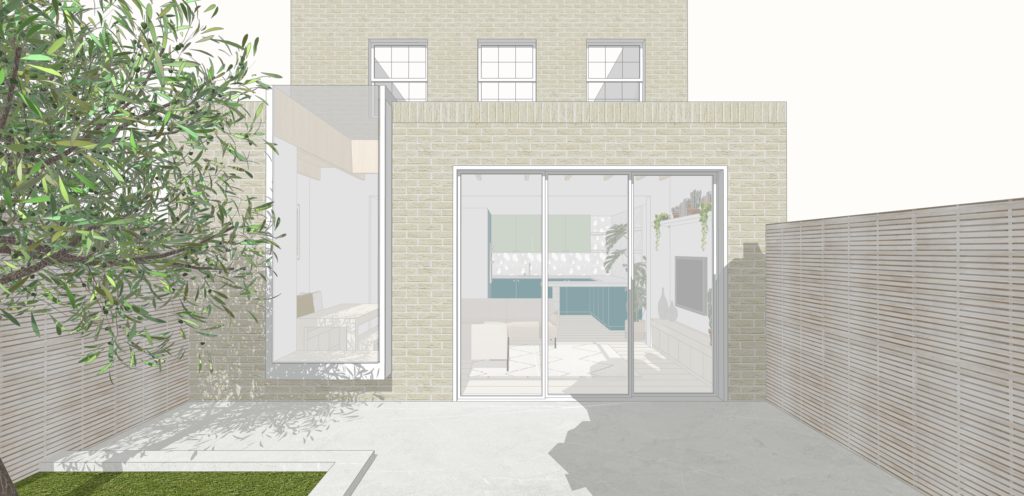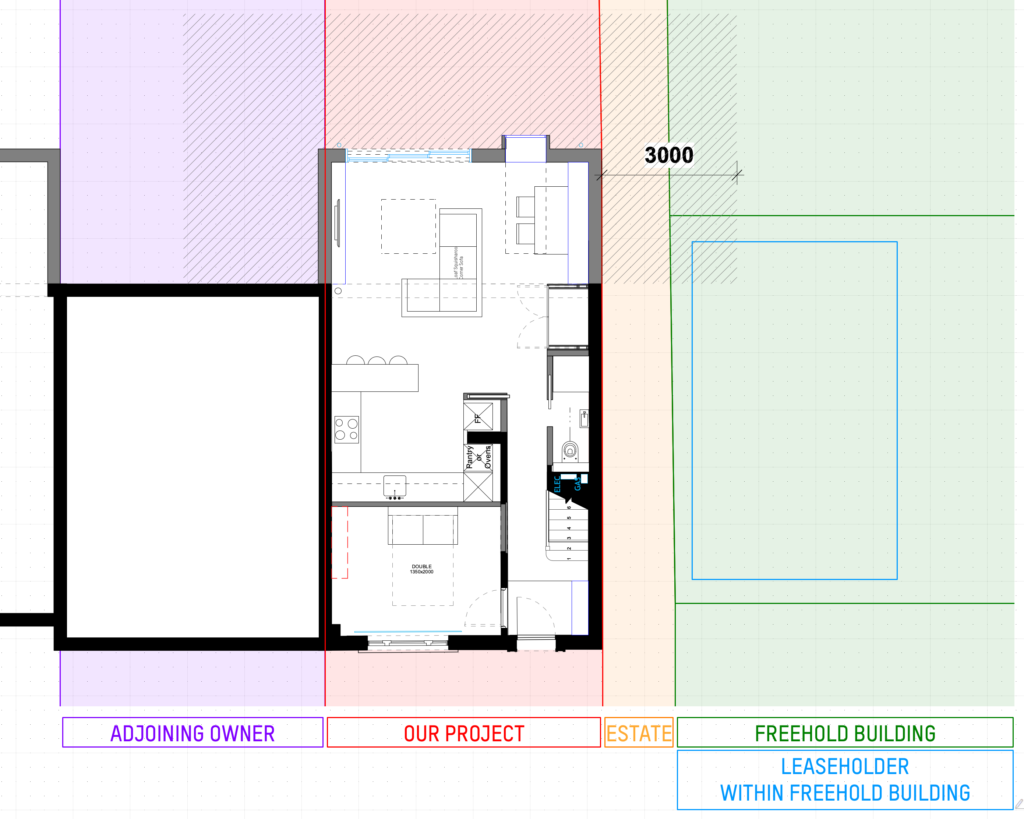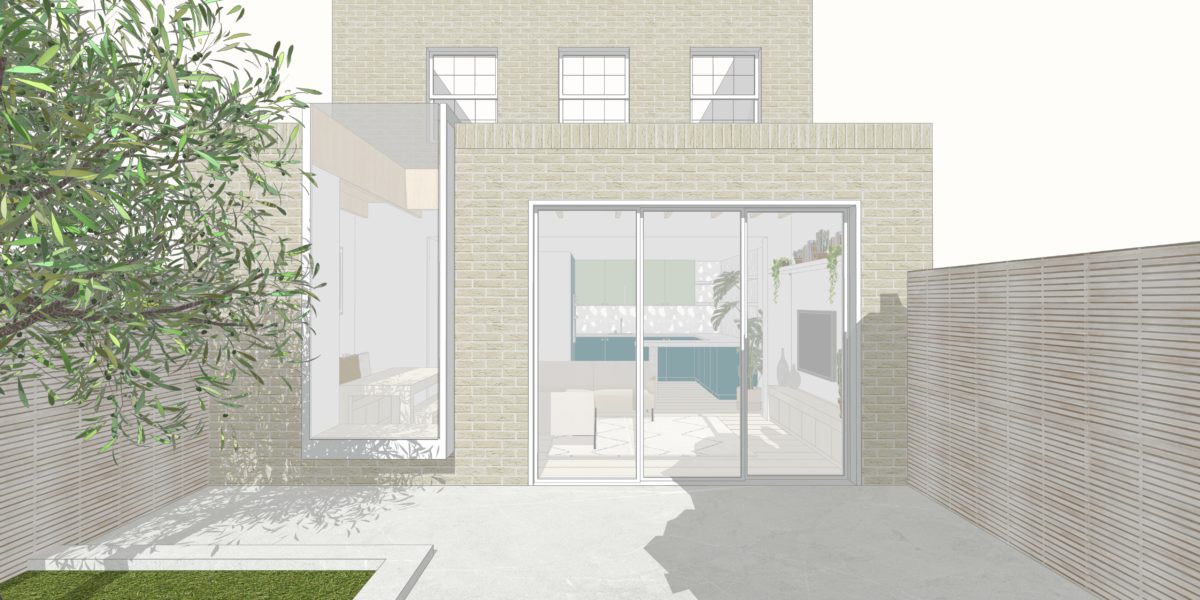A party wall separates a semi-detached, terraced or apartment home from its neighbours, and its ownership is shared by those on both sides of it.
This shared ownership means that when you carry out structural renovation works to your home that impact the party wall, you must inform your neighbours. A party wall surveyor who acts as an impartial consultant, representing the best interests of both the person renovating and their neighbours, should be brought on board to serve the appropriate notices and ease discussions. We find most people are unaware of the need for a party wall surveyor when they first approach us about a project – unless they have renovated before or done some in-depth research. Our role as architects is to build the team of experts you need to carry out our project and manage them on your behalf for a smooth-running process. This includes introducing the integral role a party wall surveyor will play in your project early on in our discussions, recommending a surveyor we have had a positive experience working with and outlining the cost in our fee proposal from the outset.
What does a party wall surveyor do?
A Party Wall surveyor will administer the Party Wall etc Act 1996, a piece of legislation that homeowners are legally obliged to follow if they are undertaking certain building works.
These works might be creating a side return extension that uses the party wall as a support, or taking the roof off and exposing the party wall to carry out a loft extension. The Act also applies to excavation works within three metres of a party wall, if the depth of excavation will reach below the existing foundations of the property.
The surveyor will prepare and serve notices to your neighbours prior to any work commencing, carry out condition surveys of properties affected and finally reach a party wall award. This is a legally binding document that sets out conditions for how the work will be carried out, a timeframe for beginning and completion, and who will pay the fees. These measures protect everyone – our clients, but also their neighbours.
“The moment you consider touching the party wall or excavating within three metres, you must serve notice,” says Mark Simpson, a party wall surveyor at David Maycox & Co, who is currently working as a consultant on one of our projects.
While homeowners can prepare and serve notices themselves, we would advise against it. A party wall agreement is there for everyone’s peace of mind in case something goes wrong and is best administered by a party wall surveyor who has carried out this role countless times before.
“It’s very important to get your party wall surveyor involved at the earliest opportunity, even if it’s just for initial advice,” says Mark. “Notices need to be served properly. That includes undertaking land registry checks on the adjoining owners’ properties to find out who owns them, preparing and serving the notices with the correct information to validate them, and then serving them by post or by taking them to the adjoining owners’ property.”
A party wall award must come in advance of commencing any work and is an indispensable part of the process. “It’s very important that your award is served prior to undertaking any notifiable works otherwise your works are deemed unlawful,” warns Mark.
Notice periods
The length of notice period you must give to your neighbours varies depending on the work being undertaken. We will guide you through this process.
Section 3 and Section 6 of the Act lay out the terms for works directly to a party wall and excavations works. These works require a notice period of two and one month respectively before any work can commence.
More than one party wall surveyor may be needed
Your neighbours will be given three options when served with a party wall agreement: consent to the works, dissent to the works and appoint your chosen party wall surveyor, or dissent to the works and appoint their own party wall surveyor.
While a party wall surveyor is impartial, acting in the best interest of both yourself and your neighbours, neighbours have the right to appoint their own party wall surveyor to completely rule out any perceived conflict of interests. This third option is therefore the most commonly selected by neighbours, and additional party wall surveyors will be appointed at the home renovator’s expense. When you share a party wall with multiple neighbours the same process applies.
The party wall surveyor or surveyors will then visit all the properties involved to carry out condition surveys that offer a visual record of the existing states of the neighbouring property or properties.
The party wall surveyors will then come to an agreement on any remedial works required due to the project, such as compensation to replace planting and garden fencing or for internal redecoration, and consider any conditions required to make the work less disruptive for neighbours.
Resolving disputes
When a party wall award is granted by the surveyors, any disputes between neighbours have typically been resolved as a result of counter-notices proposing amended changes to the agreement.
But homeowners have 14 days to appeal a party wall agreement to a county court if they are not satisfied.
“That occurrence obviously is very rare. I have never had an award appealed in over 20 years, but we do sometimes come across obstructive adjoining owners,” says Mark. “I am there to enable the building owner to carry out their notifiable works at the earliest opportunity, whilst protecting the interests of the adjoining owners.”
The cost of a party wall agreement
Party wall surveyors typically work on a time-based rate. David Maycox & Co suggest a fee of £800-1200 based on 6-8 hours for a typical project, but prices vary drastically on the company you choose and its location. We have a roster of party wall surveyors we suggest to clients, whose fees we will provide guidance on at the outset of your project. But you are also free to take a word-of-mouth recommendation from a friend or family member.
We find the trickiest scenario is when a project is next to multiple flats that all share the party wall. Here, you might need an agreement with each one of those flats, which is where the process can become complicated and costly. We include likely multiples in our initial fee proposal for renovators to help factor in the cost of additional party wall surveyors and always recommend a contingency of 10-15% of your overall budget for unforeseen costs.
Case study: House for an Olive Tree

We are currently working on a small end-of-terrace house in Islington, north London. The scope of the works from a party wall perspective includes the removal of a chimney breast and the addition of a single-storey rear extension. On this project, there are a total of four “adjoining owners” who are all notifiable under the Party Wall Act, and it is the client’s responsibility to ensure that they safeguard their neighbours’ interests.
We are working with party wall surveyors Hayley Glassman of Anstey Horne & Co on this project, who have helpfully shared the break-down of the complex process in hand.

The area highlighted in purple
Our clients wish to build the new flank wall of their rear extension astride the boundary line with their adjoining neighbours.
Building astride the boundary means creating a new party wall between the two neighbours – a wall shared by both and positioned at the centre of the ownership boundary line.
This arrangement benefits both parties by creating additional floor space within the extension. It also means the neighbours have future rights to make use of the new party wall if they decide to at some stage do their own building works.
Building astride the boundary is not an automatic right and the neighbours do have to give written consent in advance.
The area highlighted in orange
On the other side of our client’s property is a narrow pathway leading to a set of garages. This means our clients will also need to serve notice to the adjoining landowner to allow them to build their new wall up to the boundary.
The serving of this notice will give the client rights of access to the adjoining land to build the new wall.
The area highlighted in green
Just beyond the pathway is an apartment block. As our client’s project will require the excavation of new foundations within 3 metres of their building, they are required to serve notice for the excavations on the freehold owner.
The area highlighted in blue
Any leasehold owners within this apartment block in close proximity to the works (within 3 metres) are also notifiable. In this case, one other leasehold interest has been identified.
More from our knowledge base


